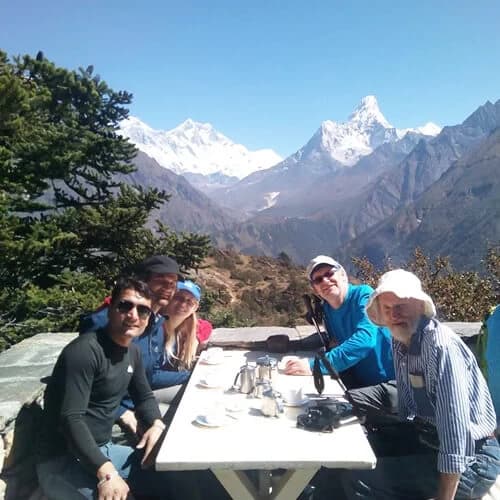Proper gears mean you’re safer!
It's crucial to invest in good gear! You'll be exposed to harsh weather conditions while trekking the Everest Base Camp trail, so make sure your gear is up to the task! It would be tough to discover too late that your inexpensive layers of clothing aren't keeping you warm, or that your sunglasses had broken. Make an investment in equipment that you know will last.
In Kathmandu, you may buy trekking poles, caps, gloves, socks, down jackets, sleeping bags, chocolate, and even medications. Everything is quite cheap in Thamel! There are both fake and genuine North Face, Mountain Hardwear, and Marmot gear available at affordable pricing.
There are also legitimate places where you may get proper mountaineering gear. Authentic Mountain Hardware and North Face store with fantastic deals! In Nepal, you'll find everything you'll need to climb Everest Base Camp. You can acquire it if you need it or if you forgot it.
A good guide is a must!
The best way to stay safe on the Everest Base Camp path is to hire a skilled guide. We always recommend hiring qualified, licensed guides at Outfitter Nepal, and this list is no exception! A qualified guide will be familiar with the trail as well as local weather trends and how to respond to them. In addition, a qualified guide should be familiar with first aid and best practices in the event of an emergency.
A good guide can make the difference between making it to Everest Base Camp and not making it. And we can assure you that our guides at Outfitter Nepal will make your trip to the Everest Base Camp both comfortable and enjoyable!
Be prepared physically as well as mentally!
You'll need to prepare for a long trek that takes a few days! This is particularly important on the trek to Everest Base Camp and the Everest region when the air is thin and your body uses more oxygen than it receives.
It is critical to have specific physical fitness. You're not running a marathon; instead, you're climbing up and down the sides of massive mountains on your way to Mount Everest. All of this is accomplished while carrying at least a 6kg/12lb weight on your back. Plus, some days are longer than others.
Your leg strength and endurance training must be your main priorities. It's critical to gradually increase the length of your hikes from 3 to 6 hours, while also increasing the amount of elevation gained and lost. Mixing up your workouts with biking, swimming, and weights can also help increase your stamina and core strength. Strengthen your leg muscles!
The trek to Everest Base Camp will not only be physically demanding but also mentally demanding. As corny as it may sound, a strong and resolute spirit will carry you through a challenging day better than years of gym training. The mind can push the body to its limits, but if you don't have the spirit to keep going, all those months (or years!) of training will be for nothing. Prepare yourself mentally too.
Make sure you get your insurance for the Everest Base Camp trek!
On an adventurous voyage such as trekking to Everest Base Camp, you never know what awaits you. To be cautious, you should always check your insurance before leaving the house. Check with your travel insurance providers to see if their policy covers mountainous adventures before filling out your insurance paperwork.
In mountainous places, many insurance policies do not cover you over a particular altitude. As a result, you should look for insurance companies that offer policies that cover your insurance during the Everest Base Camp Trek, which reaches a maximum altitude of 5,545 meters.
One of the most compelling reasons to purchase complete insurance for this trip is that, while emergency services are accessible, they are prohibitively expensive. A single rescue helicopter might set you back $5,000 or more. Thus, we recommend you get insurance that fully covers everything for your safety!
Choosing a reliable trekking company
You can go on a trek to Everest Base Camp in three ways:
- Booking a tour and have everything taken care of for you.
- Make the journey to Everest Base Camp on your own.
- When you arrive in Nepal, hire a guide or porter on your own.
Many tour operators provide appealing tour packages, but it is best to go with travel services that are established locally. To begin with, local companies know the area better than anyone else. Having local specialists join you on your trek provides you with greater freedom and authenticity. They'll also accompany you on your journey and give safety hacks, tips, and tactics. The company's local guides are more knowledgeable about the customs and culture. As a result, they can provide you with a greater understanding of the societies you encounter.
However, if you want to book a trekking company, you must make sure you choose a reliable one!
Outfitter Nepal, we have extensive expertise conducting treks in Nepal's Himalayas. Our various Everest Base Camp or Everest Region Trekpackages will allow you to go on the most thrilling adventure of your life.
Join us on one of our Everest Base Camp Trek departure dates, or get in touch with us to tailor an Everest trek to your specific needs. Enjoy this exhilarating, breathtaking journey knowing that our qualified, experienced guides and porters will be ready to assist you at every turn.
At Outfitter Nepal, we go to great lengths to ensure that all of your trekking aspirations come true. We look forward to assisting you in creating lifelong memories on your holiday, which can be completely tailored to your preferences. Come, join us!
A break after the Everest Base Camp trek is really important!
You must prioritize your health and safety even after you have finished your Everest Base Camp Trek. Thus, make sure you still have a few days at hand before you leave for home. Get ample rest after all the hard work you’ve done in the past few days. Meanwhile, you can also have short sightseeing tours with us at Outfitter Nepal.
To top it off, sometimes the flight from Lukla gets delayed due to bad weather. What are you going to do about that then? You should book your flight for your home keeping a few days in hand. That way, there’s no chance that you will miss your flight!
Have vegetarian food wherever possible and make sure to hydrate yourself regularly!
While meat consumption along the trek is safe, eating meat once you've passed Namche Bazaar is highly discouraged. After that, everything is taken up the mountain on foot or by yak. It's almost certain that the meat won't be fresh.
And to make things worse, your digestive system is under stress as it tries to adjust to the high altitude. So fresh Nepali food, dal-bhat, and vegetables are your best bet. You could also eat an unlimited supply of Nepali momo and other dishes. You'll be OK if you stick to fresh meals.
Even in non-mountainous settings, dehydration is no laughing matter, therefore staying hydrated while trekking to Everest Base Camp should be one of your top considerations! Dehydration can contribute to the onset of altitude sickness as well as accelerate tiredness. Higher altitudes cause the human body to dry, thus staying hydrated is essential for a successful hike.
Maximize your acclimatization!
To begin, your plan should include as much acclimatization as possible. You'll have a safer experience in a low-oxygen atmosphere if you spend more time at this elevation. This extra time during the acclimatization phase aids in the production of more red blood cells, allowing you to transport more oxygen and safely ascend to higher elevations.
Because only a few people make it to the Everest region, it is critical to acclimate well lower down before moving higher. Years of experience have taught us that if you spend less time acclimatizing than we recommend, you risk the danger of developing significant AMS (high altitude sickness). If you spend fewer days acclimatizing, your chances of success decrease. Thus, we highly recommend you maximize your acclimatization.
Make sure you go SLOW, it’s not a marathon!
On the Everest Base Camp Trek, getting the pace right is crucial to your success! At Outfitter Nepal, we know how to bring you to Everest Base Camp safely and then back down again. This does not imply that you should arrive unprepared.
For the Everest region trek, you must be thoroughly trained and prepared. Descending is far more difficult than going up, thus leg strength is also important to address!
Stay alert at all times, especially on risky slopes!
There are numerous physical threats while you're on an Everest Base Camp Trek! People, porters, yaks, donkeys, rockfalls and landslides, and avalanche falls are just a few of the hazards you might face. To avoid injury, you must always be aware of your surroundings.
In high-risk zones, you should also keep a close eye on each step you take. On the path, your safety must always come first. Always stay on the mountainside of the trail and keep a safe distance from any cliffs.
Make sure to treat your cold water or get boiled/filtered water!
If you acquire cold water in your bottle while hiking, you must purify it with purification pills before drinking it or get a SteriPen! Your Everest base camp trip will be ruined if you drink contaminated water. Bottled water is quite expensive as well. Thus, make sure you bring enough water purification tablets on your journey. You could also bring a gadget like a SteriPen with you on the journey, but we've found that using tablets is the most convenient, effective, and cost-efficient alternative.
And on your hiking day, your water supply may be over sooner than you expect. On resting spots, at teahouses, make sure to get either boiled or filtered water from the teahouses. This may cost you some money. But this way, you are drinking purified water and not at the risk of catching water-borne diseases that may ruin your Everest Base Camp trek!
Protect your skin and your eyes from scorching sun rays!
Higher altitudes indicate a thinner atmosphere, which further implies less ozone protection and greater sun damage! Dehydration, sunburns, and snow blindness can all occur due to too much sun exposure. It's a good idea to wear sunscreen and sunglasses to stay protected. We recommend sunscreen with at least 50++ SPF. Wear them regularly and protect yourself from unnecessary risk!
Maintain your hygiene!
On the Everest route, there are now more showers, western toilets, sinks, and mirrors than ever before. In most of the lodges, the cuisine is also better and more freshly cooked. At Outfitter Nepal, we take you to good lodges on our treks, however, lodges in certain areas may not be as luxurious as back home.
More so, you’ll need to use hand sanitiser, trim your nails, keep your body clean, and make sure you're not getting sick from dirty hands or unclean surfaces. Keep in mind that you're in a remote wilderness area with few resources and services, so keep clean for a more comfortable hike up the trail.
This suggestion may seem odd, but the trek will be windy, and you won't have many opportunities (or want!) to bathe in near-freezing conditions. If you have long hair, keep it wrapped back in a braid or bun so it doesn't become a hopeless tangle!
Carry your power banks for charging your gadgets!
Though most trekking trails in the Everest region include charging points and electricity, it's better to bring your power bank just in case.
Charge your electronics with a pair of portable power banks. A power bank with at least 20000mAh Portable Charger with Dual USB Ports is recommended. You'll be able to charge two devices at once and have at least four charges.
We also advise solar chargers that can be attached to your daypacks while trekking so that the sun can charge your electronics during the day. This way, you have a backup if your power banks run out of juice.
Carry a first aid kit for your medical safety!
A good first aid kit is the one item you'll need on the trail. The days are long, and first aid treatment and equipment will not be readily available during the trek. We recommend including items such as Diamox for altitude, Decongestants, Pin Killer, Lip Balms, Sunscreen, Band-Aids, Wet wipes or anything you feel you require for immediate aid!
The trek to Everest Base Camp is quite challenging. It should be challenging, considering all of the remarkable things features it offers. However, with the proper planning, this trek can be completed with ease. We hope that the tips we compiled help you prepare for a safe Everest Base Camp Trip!
Some Most Popular Treks




